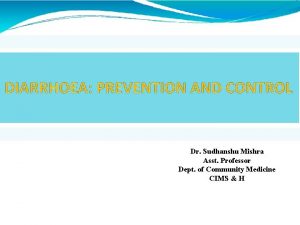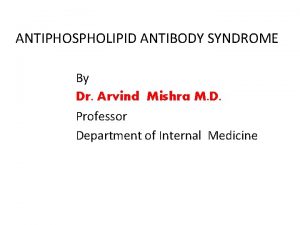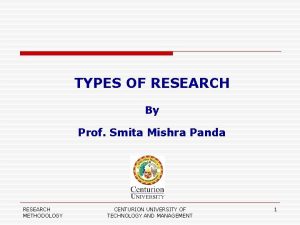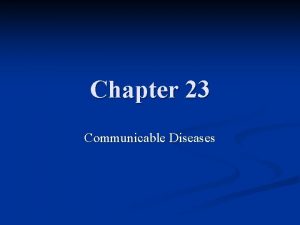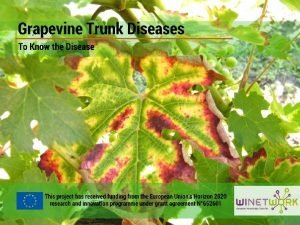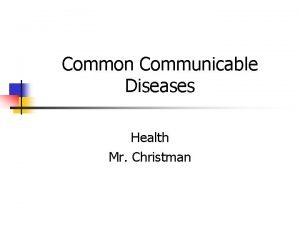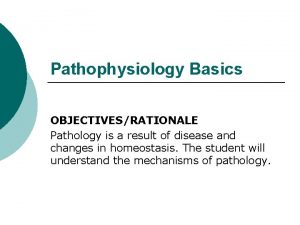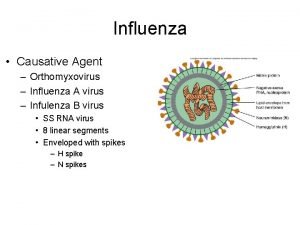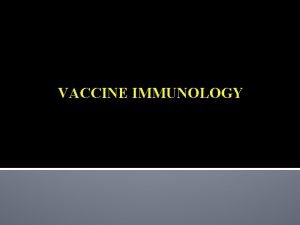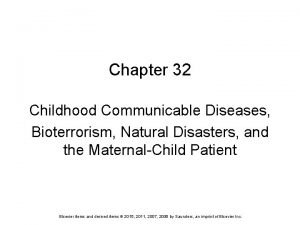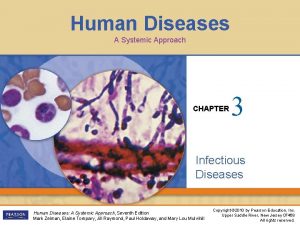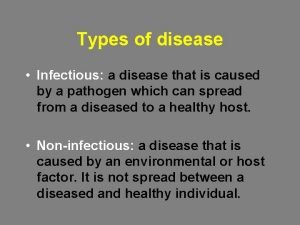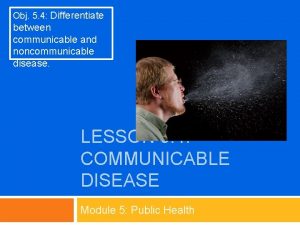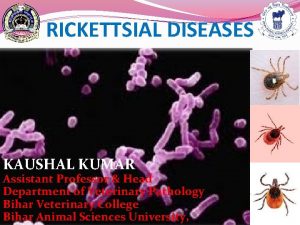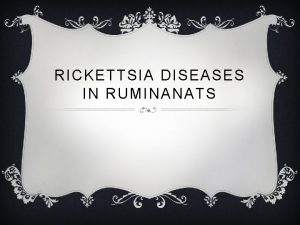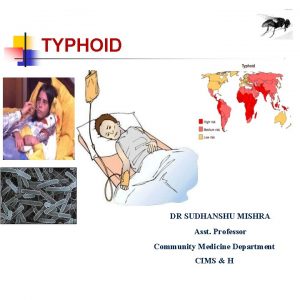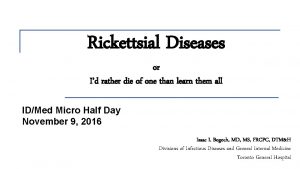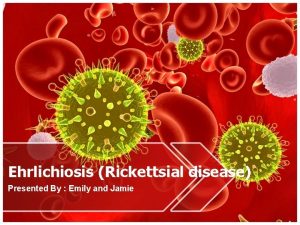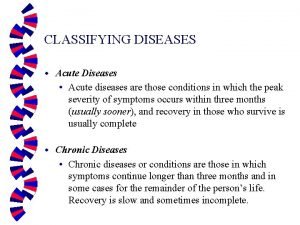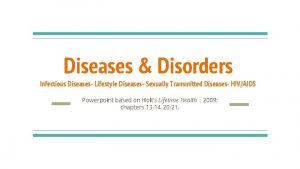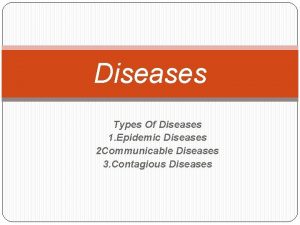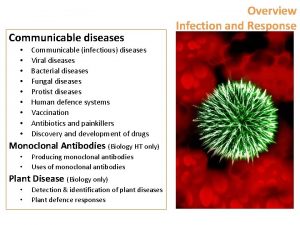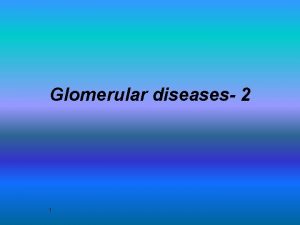Rickettsial Diseases Dr Sudhanshu Mishra Assistant Prof Department






















































- Slides: 54

Rickettsial Diseases Dr. Sudhanshu Mishra Assistant Prof. , Department of Community Medicine Career Institute of Medical Sciences & Hospital

Introduction • Rickettsiae – small, gram negative intracellular parasitism. bacilli adapted to obligate • Transmitted by arthropod vectors. – primarily parasites of arthropods such as lice, fleas, ticks and mites, in which they are found in the alimentary canal. – In vertebrates, including humans, they infect the vascular endothelium and reticuloendothelial cells.

• The family Rickettsiaeceae currently comprises of three genera: i. Rickettsia ii. Orientia iii. Ehrlichia • Former members of the family which have been excluded: i. Coxiella burnetii (causes Q fever) is not primarily arthropod borne ii. Rochalimaea quintana (causes trench fever) is not an obligate intracellular parasite, being capable of growing in cell‐free media, besides being different in genetic properties.

History • Hippocrates (460 BC) – Typhus meaning ‘confused state of the intellect’ associated with fevers. – As ‘febrile, exanthematic illness, associated with nervous system’ described in L’epidemion. • Thucydides (430‐ 425 BC) – ‘Classical epidemic typhus’ vs. Plague vs. Measles vs. Smallpox.

• Civil wars in Granada (in 1492) – Six times more people were killed from febrile illness termed Tabardillo (Spanish ‘red cloak’) than in battle. • Siege‐warfare (in 1494) – French Imperial Army’s siege of Naples • During 1485‐ 1551 – Five epidemics ‘English sweat’ occur in UK.

• Girolamo Fracastoro – Fracastorius (in 1546) – Differentiated ‘plague’ from ‘typhus’ – described in De contagion et contagiosis morbis (‘On Contagion and Contagious Diseases). • Napoleone’s Grande Armee (in 1812) – Reduced over 42 fold (from 422000 men to 10000 men) during invasion of Russia – Majority dying from typhus rather than combat.

• The Second World War (1942‐ 1945) – Scrub typhus: 18000 cases and 639 deaths – Murine typhus: 787 cases and 15 deaths • Major impact on Scrub Typhus research – Improvements in diagnostics, prevention, epidemiology, clinical management, transmission.

• During outbreaks in armies, ships and prison, following measures were taken: – Burning of clothes – Changing of bedding – Crude quarantine measures • These were found to be very effective in – reducing mortality, – promoting the understanding of the ‘epidemic’ and ‘contagious’ notion of the disease.

‘Dissection of Typhus’ and Creation of Rickettsiology • In 19 th Century, ill‐defined entity of ‘typhus’ was dissected into triad of – Typhus, – Typhoid – Relapsing fevers • Based on refinement of clinical syndromes – ‘exanthematic fevers’, ‘abdominal or enteric fevers’ and ‘recurrent fevers’

‘Dissection of Typhus’ Exanthematic fevers Abdominal or Enteric fevers Typhus Typhoid Putrid malignant fevers Slow nervous fever Relapsing fever Recurrent fevers

• Charles Nicole (in 1909) – Demonstrated Pediculus corporis (body louse) was the vector of epidemic typhus • Howard Taylor Rickets (in 1910) – Described rickettsial organisms in blood of typhus patients and in infected lice and their feces • Howard Taylor Rickets and Stanislaus von Prowazek – Died from typhus acquired during their research efforts

Rickettsial Diseases • • Scrub typhus Epidemic typhus Murine Typhus Indian tick typhus Brill Zinser disease Rocky Mountain Spotted Fever Other tick borne infections

Weil‐Felix Test OX 19 OX 2 OXK* 0 0 Epidemic Typhus ++++ + +++ 0 Murine Typhus ++++ + 0 Indian tick typhus + ++++ 0 Brill Zinser disease ++++ + RMSF ++++ + 0 0 + ++++ 0 Scrub Typhus Other tick borne infections Weil & Felix (In 1916, ) and *Dr. A. N. Kingbury (in 1924)

Scrub Typhus • • • ‘Chigger borne typhus’, ‘tsutsugamushi fever’. A bacterial disease. Caused by Orientia tsutsugamushi Spread through trombiculid (“chigger”) mites. Rodents are usually infected, while humans are accidental hosts.

• First described from Japan in 1899. – where it was found to be transmitted by mites. • The disease was called ‘tsutsugamushi’ – ‘tsutsuga’ meaning dangerous – ‘mushi’ meaning insect or mite.

• The term “scrub” is used because of the type of vegetation (terrain between woods and clearings) that harbours the vector. – “tall‐growing coarse grass”, – forests, – gardens, – beaches, – paddy fields, – bamboo patches and – oil palm or rubber estates.

Geographical distribution • Scrub typhus is endemic to a part of the world known as the “tsutsugamushi triangle” – extending from northern Japan and the far‐eastern Russian Federation to northern Australia and Pakistan. – includes Bhutan, India, Indonesia, Maldives, Myanmar, Nepal, Sri Lanka and Thailand.


• Probably one of the most underdiagnosed and underreported febrile illnesses requiring hospitalization in the SEAR. – estimated 1 billion people are at risk for scrub typhus and – estimated 1 million cases occur annually. • The case‐fatality rate in untreated cases varies from 1– 60% according to: – area, strain of infectious agent, and previous exposure to the disease; – it is consistently higher among older people.

Scrub typhus‐affected countries of Asia

Scrub typhus in India • Specific data are not available. • Outbreaks in areas located in the sub‐Himalayan belt, from Jammu & Kashmir to Nagaland. • Reported from Rajasthan and Vellore. • Scrub typhus is a re‐emerging infectious disease in India.

• In India, the disease had occurred among troops during World War II in Assam and West Bengal, and in the 1965 Indo‐Pak war. • There was a resurgence of the disease in 1990 in a unit of an army deployed at the Pakistan border of India. • There were reports of scrub typhus outbreaks in Himachal Pradesh, Sikkim and Darjeeling (West Bengal) during 2003‐ 2004 and 2007.

Characteristic feature of an outbreak of scrub typhus i. the obvious association with certain types of terrain; ii. the marked localization of many cases within certain small foci; iii. the large percentage of susceptible people, who may be infected simultaneously following exposure over relatively short periods; iv. the absence of a history of bites or attack by arthropods

Seasonal Occurrence • The period of epidemic is influenced by the activities of the infected mite. • It occurs more frequently during the rainy season. – However, outbreaks have been reported during the cooler season in southern India. • Areas such as forest clearings, riverbanks, and grassy regions provide optimal conditions for the infected mites to thrive.

Agent • Orientia tsutsugamushi – a small (0. 3 to 0. 5 by 0. 8 to 1. 5 μm), gram negative bacterium of the family Rickettsiaceae. – differs from the other members in its genetic make up and in the composition of its cell wall structure – it has five major serotypes. Reservoir – Chigger mites act as the primary reservoirs for O. tsutsugamushi.

Vector • Chigger mites (Leptotrombidium deliense and others) – – very small in size (0. 2– 0. 4 mm) can only be seen through a microscope or magnifying glass. inhabit sharply demarcated areas in the soil where the microecosystem is favourable (mite islands). either established forest vegetation or secondary vegetation after clearance of forest areas. abundant on grasses and herbs where bushes are scarce.

Mode of transmission • Human beings are infected when they trespass into mite islands and are bitten by the mite larvae (chiggers). • The mite feeds on the serum of warm blooded animals only once during its cycle of development, • Adult mites do not feed on man. • The microbes are transmitted transovarially in mites. • Scrub typhus normally occurs in a range of mammals, particularly field mice and rodents. coexisting – Mite coexist primarily with rodents and other small mammals.

Mode of transmission

Risk factors for Human Infection • Scrub typhus is essentially an occupational disease among rural residents in the Asia‐Pacific region. • An increase in the prevalence of scrub typhus has been reported from some Asian countries, which coincides with urbanization of rural areas.

Habitats favourable for disease transmission • Scrub typhus, originally found in scrub jungles, has also been identified in a variety of other habitats, such as sandy beaches, mountain deserts and equatorial rain forests. Incubation period • 5– 20 days (average 10– 12 days) after the initial bite.

Clinical signs and symptoms • The chigger bite is painless • May be noticed as a transient localized itch, often found on the groin, armpits, genitalia or neck. • A papule develops at the site of inoculation. • The papule ulcerates and eventually heals with development of a black eschar.

• Sudden shaking chills, high grade fever, severe headache, photophobia, myalgia, apathy, and swelling of the lymph nodes are also seen. • Approximately one week later, a spotted and then maculopapular rash appears first on the trunk and then on the extremities and blenches within a few days. • Complications may include pneumonia, meningoencephalitis and myocarditis.

Diagnosis • • Indirect Immunoflorescence Antibody (IFA) Indirect Immunoperoxidase test (IIP) Complement Fixation Test Weil‐Felix Test ELISA PCR Isolation of the organism Investigation may reveal early lymphopenia with late lymphocytosis. Albuminuria is a common laboratory finding.

Differential Diagnosis • • • Other rickettssial diseases Malaria Dengue Chikungunya Leptospirosis Relapsing fever Typhoid Meningococcal disease Viral fevers

Treatment • Doxycycline: the drug most commonly used. – 100 mg BD X 7‐ 15 days • A combination therapy with doxycycline and rifampicin – in areas where there is poor response to doxycycline alone. • Azithromycin or chloramphenicol – is useful for treating infection in children or pregnant women.

Prevention and control Individuals • In endemic areas, wear full‐length clothing, socks and shoes. • Avoid walking barefoot. • Apply, as necessary, insect repellents containing dibutyl phthalate, benzyl benzoate, and diethyltoluamide (DEET), to the skin and clothing to prevent chigger bites. • Do not sit or lie on bare ground or grass.

Community • Rapid case identification by health‐care workers can help provide prompt treatment. • Public education on case recognition and personal protection will help in the identification and prompt treatment of cases. • Rodent control and improved living conditions will help prevent spread of the disease. • Clear vegetation and do chemical treatment of the soil to help break the cycle of transmission.

Epidemic Typhus • Louseborne typhus, Classical typhus, Gaol fever • One of the great scourges of mankind, occurring in devastating epidemics during times of war and famine.

• Reported from all parts of the world but has been particularly common in Russia and Eastern Europe. – During 1917‐ 1922, there were some 25 million cases in Russia, with about three million deaths. • In recent times, the main foci have been Eastern Europe, Africa, South America and Asia. • In India, the endemic spot is Kashmir.

• The causative agent of epidemic typhus is R. prowazekii. • Humans are the only natural vertebrate hosts. – Natural infection in flying squirrels has been reported from South‐ eastern USA. • The human body louse, Pediculus humanus corporis, is the vector. – The head louse may also transmit the infection but not the pubic louse.

• The lice become infected rickettsiaemic patients. by feeding on • The rickettsiae multiply in the gut of the lice and appear in the faeces in 3‐ 5 days. • Lice succumb to the infection within 2‐ 4 weeks, remaining infective till they die. • They can transmit the infection after about a week of being infected.

Transmission • Lice may be transferred from person to person. – Being sensitive to temperature changes in the host, they leave the febrile patient or the cooling carcass and parasitise other persons. • Lice defecate while feeding. • Infection is transmitted when the contaminated louse faces is rubbed through the minute abrasions caused by scratching. – Occasionally, infection may also be transmitted by aerosols of dried louse faces through inhalation or through the conjunctiva.

• Incubation period: – 5 ‐ 15 days

Clinical Presentation • The disease starts with fever and chills. • A characteristic rash appears – on the fourth or fifth day, – starting on the trunk and spreading over the limbs but sparing the face, palms and soles. • Towards the second week, the patient becomes stuporous and delirious. – The name typhus comes from the cloudy state of consciousness in the disease. • The case fatality may reach 40% and increases with age.

• In some who recover from the disease, the rickettsiae may remain latent in the lymphoid tissues or organs for years. • Such latent infection may, at times, be reactivated leading to recrudescent typhus or Brill Zinsser disease.

Endemic Typhus • ‘Murine typhus’ • A milder disease than epidemic typhus. • In India, endemic typhus has been reported from Pune, Lucknow, Mysore, Kolkata, Golkunda, Karnal, R ewari and Kashmir.

• Endemic typhus is caused by R. typhi – it is maintained in nature as a mild infection of rats. • It is transmitted by the rat flea, Xenopsylla cheopis. – The rickettsia multiplies in the gut of the flea and is shed in its faeces. – The flea is unaffected but remains infectious for the rest of its natural span of life.

• Humans acquire the disease usually through the bite of infected fleas – when their saliva or faeces is rubbed in or through aerosols of dried faeces. • Ingestion of food recently contaminated with infected rat urine or flea faeces may also cause infection. • Human infection is a dead end. – Man to man transmission does not occur.

Clinical presentation • Endemic typhus resembles many other illnesses and very few patients are provisionally diagnosed correctly. • Headache and fever (in 12% of cases) • Rash develops in 54% of patients. • Nausea, vomiting, diarrhoea and abdominal pain suggest gastrointestinal diseases while cough and abnormal chest radiograph suggests pneumonia or bronchitis. • Severe illness including seizures, coma, renal insufficiency and respiratory failure are seen in approximately 10% of cases, only 1% of cases are fatal.

Spotted Fever Group • They are all transmitted by ticks, except R. akari, which is mite borne. • Rickettsiae of this group possess a common soluble antigen and multiply in the nucleus as well as in the cytoplasm of host cells. • Many species have been recognized in this group. Organism R. rickettsi R. siberica R. conori R. australis R. japonica Disease Rocky mountain spotted fever Siberian tick typhus Indian, Mediterranean, Kenyan and South African tick typhus Queensland tick typhus Oriental spotted fever

• The rickettsiae are transmitted transovarially in ticks, which therefore act as both vectors and reservoirs. • The infection may be transmitted to vertebrate hosts by any of the larval stages or by adult ticks. • Ticks are not harmed by the rickettsiae and remain infected for life.

• The rickettsiae are shed in tick faeces but transmission to human beings is primarily by bite, as the rickettsiae also invade the salivary glands of the ticks. • All rickettsiae of this group pass through natural cycles in domestic and wild animals or birds.

Tick Typhus (Indian Tick Typhus) • Tick typhus, in several parts of Europe, Africa and Asia is caused by R. conori, strains of which isolated from the Mediterranean region, Kenya, South Africa and India are indistinguishable.

• Tick typhus was first observed in India in the foothills of the Himalayas. • Subsequently, the disease was reported from many parts of the country – Allahabad, Narsapatnam, Ratlam, Secunderabad, Trichinapally, Bangalore, Jhansi, Darjeeling, Pune and Lucknow. • The tick sp. Rhipicephalus sanguineus is the most important vector and is generally found infesting dogs all over. • Some species of Haemaphysalis and Hyalomma ticks may also transmit the infection.
 Imnci guidelines for diarrhoea
Imnci guidelines for diarrhoea Sudhanshu in japanese
Sudhanshu in japanese Dipti mishra iiit hyderabad
Dipti mishra iiit hyderabad David von flittner
David von flittner Fdi notation
Fdi notation Bud mishra
Bud mishra Liv tyler face shape
Liv tyler face shape Dr anup mishra herbalife
Dr anup mishra herbalife Kalanand mishra
Kalanand mishra Ans
Ans Nina mishra
Nina mishra Kalanand mishra
Kalanand mishra Dr padma mishra bhopal
Dr padma mishra bhopal Smita mishra panda
Smita mishra panda Le mone
Le mone X linked diseases
X linked diseases Chapter 6 musculoskeletal system diseases and disorders
Chapter 6 musculoskeletal system diseases and disorders Sarophyte
Sarophyte Sperm fructose
Sperm fructose Iceberg phenomenon
Iceberg phenomenon Similar pictures
Similar pictures Non common communicable diseases
Non common communicable diseases What causes genetic diseases
What causes genetic diseases Normal gingiva in child
Normal gingiva in child Causative organism
Causative organism Nutritional diseases
Nutritional diseases Tronsmo plant pathology and plant diseases download
Tronsmo plant pathology and plant diseases download Conclusion of plant diseases
Conclusion of plant diseases Chapter 15 nervous system diseases and disorders
Chapter 15 nervous system diseases and disorders Diseases with vaccines
Diseases with vaccines Periradicular disease definition
Periradicular disease definition Modern lifestyle and hypokinetic diseases
Modern lifestyle and hypokinetic diseases Cardiovascular system diseases and disorders chapter 8
Cardiovascular system diseases and disorders chapter 8 Epidemiological triad of malaria
Epidemiological triad of malaria Global alliance against chronic respiratory diseases
Global alliance against chronic respiratory diseases Chapter 10 nail disorders and diseases review questions
Chapter 10 nail disorders and diseases review questions Immunocompromised diseases list
Immunocompromised diseases list Whats sex linked
Whats sex linked Chapter 32 childhood communicable diseases bioterrorism
Chapter 32 childhood communicable diseases bioterrorism Chapter 22 genetics and genetically linked diseases
Chapter 22 genetics and genetically linked diseases Venn diagram of communicable and non-communicable diseases
Venn diagram of communicable and non-communicable diseases Human diseases a systemic approach
Human diseases a systemic approach Milady chapter 8 skin disorders and diseases
Milady chapter 8 skin disorders and diseases Quality gurus
Quality gurus Icd 10 morbus hansen
Icd 10 morbus hansen Nutritional diseases
Nutritional diseases Non communicable diseases
Non communicable diseases Monocyte derived dendritic cells
Monocyte derived dendritic cells Type of disease
Type of disease Plicatured nail
Plicatured nail Tronsmo plant pathology and plant diseases download
Tronsmo plant pathology and plant diseases download Venn diagram of communicable and non-communicable diseases
Venn diagram of communicable and non-communicable diseases Diseases in civil war
Diseases in civil war Section 19-3 diseases caused by bacteria and viruses
Section 19-3 diseases caused by bacteria and viruses Pulpitis classification
Pulpitis classification
